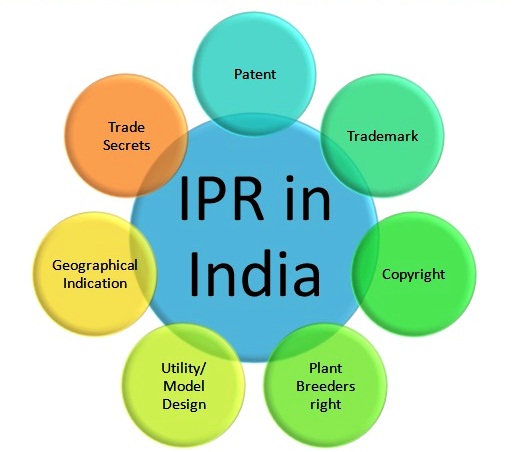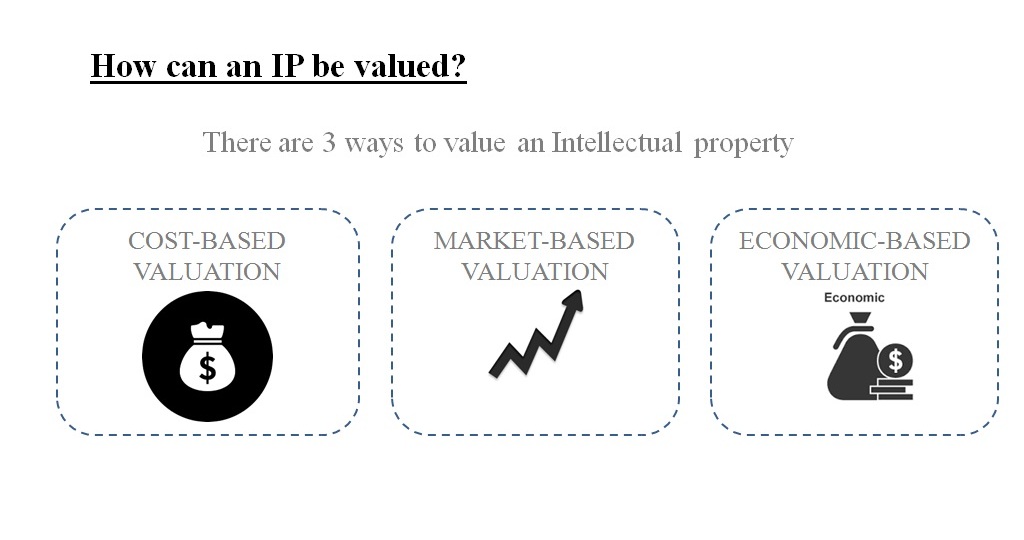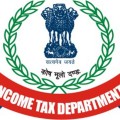
Intellectual Property Right (IPR): Meaning, Related Laws and Valuation
What is Intellectual Property Right (IPR)?
- intellectual property means creations of the intellect for which a monopoly is assigned to designated owners by law.
Intellectual property (IP) refers to creations of the intellect for which a monopoly is assigned to designated owners by law. Intellectual property rights (IPRs) are the protections granted to the creators of IP, and include trademarks, copyright, patents, industrial design rights, and in some jurisdictions trade secrets. Artistic works including music and literature, as well as discoveries, inventions, words, phrases, symbols, and designs can all be protected as intellectual property.
Intellectual property rights (IPR) include patents, copyright, industrial design rights, trademarks, plant variety rights, trade dress, geographical indications, and in some jurisdictions trade secrets. There are also more specialized or derived varieties of sui generis exclusive rights, such as circuit design rights (called mask work rights in the US) and supplementary protection certificates for pharmaceutical products (after expiry of a patent protecting them) and database rights (in European law).
What are IPRs?
- The protections granted to the creators of IP. IPRs Include trademarks, copyright, patents, industrial design rights, and in some jurisdictions trade secrets.
What all can be protected?
- Artistic works including music and literature, as well as discoveries, inventions, words, phrases, symbols, and designs.
Steps to secure an IP?
The First Step is through registration
Depending on the nature of service/product one can register their services and products as:

Protection for Copyright
What’s the Protection?
- Protection given by law for a term of years to the composer, author etc… to make copies of their work..
What’s the Scope of work for Protection?
- Work include literary, artistic, musical, films, sound recordings, broadcasts.
What’s the term of registration?
- The term of registration of a copyright for literary, artistic, musical, dramatic work is lifetime +60 years from the beginning of the calendar year next following the year in which the author dies and in other cases until sixty years from the beginning of the calendar years next following the year in which the work is first published.
What’s a Trademark?
- A symbol, word, or words legally registered or established by use as representing a company or product.
What is Patent?
- A patent is a limited right granted by the government (all patents are limited by country) that allows the inventor to stop other people or companies from making, using or selling a specifically defined invention
Protection for Patent
Basic idea of granting a patent
“ the applicant applies to the government for the right of patent and in return for the monopoly given he must disclose everything about the invention in the patent document”
Timeframe for patent?
- Patent is granted for a duration of 20 years.
- Priority date- first to file
Scope?
- Patent is for invention, it can either be applied for a product or process
- A Must have for patent
- Patentable invention must be new, involves an inventive step and industrially applicable
- Protection for industrial design
What it covers?
- Protection for industrial designs that are new or original
Defining Design
- Design are feature of shape, configuration, pattern or ornament
Application
- The design must be applied to an article
- The design must be applied by an industrial process.
- Appeal to the eye.
Protecting IPs through agreements against theft
How can IP’s be safeguarded through agreements?
Another step in seeking IP protection against theft is executing comprehensive employment agreements and non-disclosure and IP assignment agreements with clauses on non-compete, confidentiality, non-solicitation, IP protection, assignment of inventions/IP, work for hire, etc.
Special Case – Licencing to third party when licensing any IP to a third party, a detailed licensing/sub-licensing agreement must be executed.
Various Laws for Intellectual property Protection in India
- The Trade and Merchandise Marks Act, 1999
- The Copyright Act, 1957 has been amended to protect computer programs as “literary work”;
- The Patent Act, 2005.
- The Designs Act of 2000.
- The Geographical Indications of Goods (Registration and protection) Act, 1999;
- The Semiconductor Integrated Circuits Layout Design Act, 2000;
- The Protection of Plants & Varieties and Farmers Rights Act, 2001;
- The Biological Diversity Act, 2002
Valuation of Intellectual property

What’s the value of an IP?
The value of an IP is a monetary compensation that is expected to be received from licensing of an IP or from sale or exchange of other intangible assets.
How new is this concept?
The concept of valuation of intellectual property and other intangible assets of a company is new as compared to other concepts of intellectual property (IP) law.
Cost based valuation
- What is it based on?
It can either be based on historic cost or on replacement cost. A historic cost is the actual cost of creating an IP. Replacement cost is the cost to replace the asset. It is determined as to what will be the cost of creating a new trademark or a patent.
- What are the drawbacks?
This method is not recommended as there is no correlation between expenditure and subsequent value of asset. E.g. a product promoted at huge cost does not appeal the customers.
A major drawback of this method is that it is not possible to determine an exact future cost.
Market based valuation
- What is it based on?
This method can be based on the market price comparability or on comparable royal rate. Market price comparability- the value of an IP is determined on the basis of price of comparable IP products.
- How is the evaluation done?
Evaluation is done through comparable royal rates.
This requires construction of a business plan around an IP. The resulting return is then compared to the price of being owner of the asset. If the price is higher than the return, it is recommended not to buy the asset.
Economic based valuation
- What is it based on?
This method requires identification, separation and quantification of cash flow or royalty fees to IP and then the capitalization of future cash flow. Quantifying the future revenue stream can be done in view of exploited or unexploited IP.

- How is the evaluation done?
In case of capitalization, longer the period of money receipt, higher will be the risk. Risk is described in terms of discount rate which in turn is based on inflation rate, cost of capital and premium. A cash flow projection is constructed and discounted to derive a net present value. This estimated present value is the worth of the IP asset.
A word of caution……..
A major limitation of IP valuation is that it is based on estimates, assumptions and judgments than on facts. Thus it lacks accuracy.
Startups and IPR strategy
- How to choose an IPR strategy?
It is important to do a cost/benefit analysis to determine which IP protection is best suited for the business and put in place an IP strategy to obtain and sustain benefits for the business in long run, as for most startups IP is the only business asset.
- What do businesses prefer?
Startups prefer to vest and register their IP rights in their offshore company incorporated in a developed country and license the rights to its wholly owned Indian subsidiary as the IP laws in developed countries are more robust and stringent. Slightly older companies may also consider conducting an IP audit for a systematic review of the IP rights owned or acquired by the company to accurately gauge and assess its IP portfolio
New Intellectual Property Policy 2016
Finance Minister Arun Jaitley released India’s National Intellectual Property Rights (IPR) Policy recently. The Policy which is in compliance with WTO’s (World Trade Organisation) agreement on TRIPS (Trade Related aspects of IPRs), aims to sustain entrepreneurship and boost Prime Minister Narendra Modi’s pet scheme ‘Make in India.’
Seven Objectives of the Intellectual Property Policy 2016
#1 Creating awareness – The new policy aims to create awareness among all sections of society about the economic, social, and cultural benefits of IPR. It will be made a compulsory part of the curriculum in major institutions. The need to open a national research institute for IPR has also been proposed, to increase outreach.
#2 Innovation – To offset India’s growing foreign dependence, India needs to develop indigenous products. Through its national IPR policy, the government’s main thrust is to create an environment where people can think innovatively and generate innovation in every field. The policy will help mainly inventors and entrepreneurs who are dealing with an overload of knowledge and ideas that need to be protected (from infringers) through trademarks, copyrights or patents, as may be required.
#3 Balanced structure of legal framework – Protection of intellectual property can only be provided through well-defined laws, which balance the interests of the public with those of intellectual property owners. If there are no protection mechanisms in the legal system, then people will not be encouraged to create more intellectual property. The new policy will lead to stronger institutional monitoring mechanisms to curb IP offenses at the state level.
#4 Administration and Management– The policy aims to modernize and strengthen service-oriented IPR administration. Digitization of all government filings has made it quite hassle free to register trademarks online by using IP India’s Site. By 2017, the government aims to lower the average time for pending IPR applications to 18 months (down from 5-7 years) and trademark registration to one month (down from 13 months).
#5 Commercialization of IPRs – The policy aims to enable Indian companies to get value for IPRs through commercialization. Most business owners do not know how their brand impacts the value of their business. A strong brand is nothing but an intangible asset that includes trademarks, copyrights, patents and trade secrets which are the intellectual property of that company. At the time of valuation or in case if the owner is considering selling his business, then intangible assets like your intellectual property can command more value than other tangible assets. Also, a well-protected brand attracts investors as they will feel safe to invest in a company that has everything secured in legal terms to avoid any future conflicts.
#6 Enforcement and Adjudication – Protecting intellectual property with trademarks, copyrights and patents plays an essential role in monetizing innovation. By strengthening the enforcement and adjudicatory mechanisms for combating IPR infringements, a company can stop others from stealing its work. The process of opposing and safeguarding IP will involve coordination between various agencies and guiding IP owners to follow best practices to avoid digital piracy.
#7 Human Capital Development – To strengthen and expand human resources, the new policy calls for (i) new institutions and capacities for teaching, training, research and skill building in IPRs; (ii) the opening of R&D institutions; and (iii) making IPR a compulsory subject to be taught in schools and colleges. The aim is to develop a increasing pool of skilled IP experts, to facilitate the growth and judicious management of IP assets.
The Roadmap Ahead
- Further IP Protection Portfolios – Data Protection, Utility Patents, Trade Secrets
- New Modernization initiatives in IP Offices
- Increased no. of IP Professionals
- Increased no. of IPR filings in India
New Avenues for Legal Practitioners
There are lot of opportunities for patent and trademark attorneys in trademark law, intellectual property trademark copyright and patent law, intellectual property business, intellectual property insurance, intellectual property law courses, intellectual property rights lawyer. Following are some further trending opportunities in IPRs:
IP Audit: It is a systematic review of the intellectual properties owned, used or acquired by a business so as to assess and manage risk, remedy problems and implement best practices in IP asset management.
IP Valuation: Valuation is considered as one of the most critical areas in finance; intellectual property (IP) valuation is considered as one of the most important management strategic issues.
IP portfolio Management: The management of intellectual property is all about managing innovation with the procedures and processes that are required to turn that innovation into valuable patent rights. A truly strategic approach to IP management will span conception to product market release.
IP controlling & reporting: Analysis and monitoring, reports for IP benchmarking, regional controlling, external and internal reporting
The author is a practing chartered accountant and she can be reached at ca.pranjalmehta@gmail.com and facbook.com/CaPranjalMehta. The view expressed in above article is personal in nature.
Recommended Books (as per customers Reviews and Popularity) on Intellectual Property Rights:










what is an intellectual property attorney, registered patent agent, ip asset management, ip licence, top ip law firms, patent attorney, lawyers intellectual property, patent your invention, patent lawyer, ip licensing, intellectual law, managing intellectual property, international intellectual property law, theft of intellectual property, attorney patent, lawyer patent, intellectual property lawyer, inventions and patents, intellectual property search, intellectual property patent law, us intellectual property, intellectual property lawyers, intellectual property law schools, ip strategy, trademark and patent, ip value, patent companies, international patent law, intellectual rights law, patent firm, invention patent, patent and trademark office, intellectual property protection, patent invention, intellectual patents, an example of intellectual property, ip litigation, ip infringement, intellectual property rights examples, can you patent an idea, patent litigation, patent trademark licensing intellectual property, patent trademark office, business intellectual property rights, ip audit, patent law firm,
Hello, who can evaluate IPRs? What is the law governing IP valuation? Should a patent professional be a registered valuer for evaluating patents?